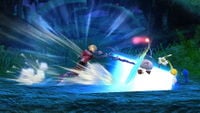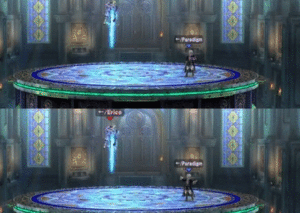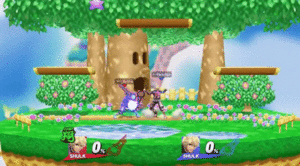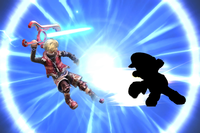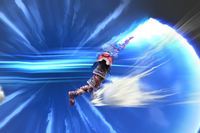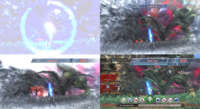Vision: Difference between revisions
(splitting pages) |
(Undid edit by Jig24: ) |
||
| Line 28: | Line 28: | ||
Every [[Monado Arts|Monado Art]] other than Jump has an effect on Vision's damage output, damage cap, and knockback. Speed and Shield will decrease damage (and knockback as a result), Buster will increase damage and decrease knockback, and Smash will decrease damage and increase knockback. These changes are significant enough that they affect Vision's knockback at 0%, such that Vision will take longer to OHKO while any of these Arts are active, to the point of requiring a move that causes Vision to deal the [[counterattack]] damage cap. | Every [[Monado Arts|Monado Art]] other than Jump has an effect on Vision's damage output, damage cap, and knockback. Speed and Shield will decrease damage (and knockback as a result), Buster will increase damage and decrease knockback, and Smash will decrease damage and increase knockback. These changes are significant enough that they affect Vision's knockback at 0%, such that Vision will take longer to OHKO while any of these Arts are active, to the point of requiring a move that causes Vision to deal the [[counterattack]] damage cap. | ||
==Vision Sliding== | |||
[[File:Vision_Sliding.gif|300px|right|thumb|Vision Sliding (standard and forward input, respectively).]] | |||
[[File:Retreating_Vision_Slide.gif|300px|right|thumb|A backwards-inputted Vision Slide used as a retreat option.]] | |||
Vision Sliding is an [[advanced technique]] which allows Shulk to significantly amplify the distance he moves upon the activation of Vision's counterattack, along with the ability to have complete control of the counterattack's momentum. It occurs when Shulk activates Vision on the exact frame he transitions from air to ground. | |||
As the timing for Vision Sliding is very strict, [[buffer]]ing Vision out of aerials is commonly done to make this easier. The standard example is using a full-hop down aerial buffered from Shulk's [[jumpsquat]], then buffering Vision during the move to force Vision to activate immediately after landing. So long as no Arts are active (or any Art that doesn't change Shulk's jump height), this will result in Vision Sliding if an attack is countered. | |||
Like a normal grounded Vision, Shulk can trigger both a standard and forward-held counterattack. However, Vision Sliding grants Shulk the ability to change the direction of the counterattack's slide by holding a direction, compared to the standard version which has no ability to do so. This freedom of movement even makes it possible to slide forwards and ''then'' backwards part-way through the animation by inputting the respective directions on the control stick. | |||
Once the initial perfect-landing Vision is inputted, all subsequent Vision counterattacks used in a row will Vision Slide until the player stops using the move. Additionally, Shulk is able to slide a tiny distance forward or back during Vision's pose, and it can be chained repeatedly just like the counterattack itself. | |||
The distance of the slide is dependent on the [[air speed]] and [[air acceleration]] granted by an Art. The Monado Arts with the longest to shortest slides are follows: Jump, Speed, No Arts/Buster/Smash, Shield. | |||
The primary applications of this technique include punishing [[projectiles]] that would otherwise outrange Vision's hitbox (similar to one of Shulk's custom down specials, Dash Vision), as well as baiting opponents to attack Shulk due to his inability to [[autocancel]], as special moves can be used before landing lag occurs as a way to defend himself. In teams scenarios, Vision Sliding can also be triggered by a teammate, allowing its large range to hit multiple opponents (even if shielding). | |||
Vision Sliding has been triggered inadvertently by players since the game was released, but it wasn't until September 2016 that Shulk mains Erico and Paradigm fully researched it. Explanations of the phenomenon along with exact setups for buffering Vision Sliding on specific stages can be seen in their [https://www.youtube.com/watch?v=xdHS77t44TU video guide]. | |||
{{clr}} | {{clr}} | ||
Revision as of 14:30, January 5, 2019
| Vision | |
|---|---|
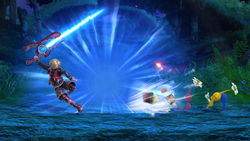 Vision in Super Smash Bros. for Wii U. | |
| User | Shulk |
| Universe | Xenoblade |
| “ | Predict and attack, prepare, and counter the attack. | ” |
| —Smash for 3DS's foldout | ||
Vision (ビジョン, Vision) is Shulk's down special move. It is a counterattack that is notable for having one of the longest counter windows in the game, along with being the only one to have two different counterattacks depending on directional inputs.
Overview
Types of Attacks
The move involves Shulk getting into a countering stance, then retaliating with a slash from the Monado if he is hit. Shulk says "A Vision...!" ("ビジョン!", Vision!) or "I see it..." ("見える...") while retaliating, and a translucent blue background appears during the counterattack (which is the backdrop used for Visions in Xenoblade Chronicles).
If no directional keys are held down, Shulk performs a large, slow forward-sliding upwards slash, capable of hitting opponents a distance away from him; this has one of the longest horizontal reaches of any counterattack, along with Double Team, Substitute and Toad. If forward is held during the counter pose (only while Shulk is grounded), he will instead perform a dashing slice through the opponent. This variant is much faster, sends opponents behind him, and has higher knockback growth (84 → 94), but has the tendency to miss more often due to the attack's speed and Shulk's forward momentum.
The regular counterattack deals a minimum of 7%/10% (beam/blade), and otherwise deals x1.3 the damage of the move that it countered. The forward counterattack has the same multiplier, but with a minimum of 10%/13% (beam/blade) instead. This counter will one-hit KO when countering a hitbox that deals at least 35% damage, and is one of the strongest counterattacks in terms of knockback, along with Ike/ Roy's Counters and Corrin's Counter Surge.
Technical Data
During the counterattack, Shulk gains intangibility right until he performs the slash. In addition, activating the counterattack slows the victim down for a brief moment (similar to a short-lasting Timer), and the slashes themselves are unblockable. However, opponents can sidestep or roll if a low-cooldown move triggered Vision, while projectiles and thrown items do not slow the victim down. Additionally, it is inadvisable to use the move offstage, due to the counterattack's slow startup and the fact that Shulk continues falling through the move.
Compared to other counterattacks in Smash 4, Vision begins countering on frame 7 (which is faster than most) and is tied for the longest counter window in the game when fresh (35 frames, the same length as Double Team). This makes it capable of countering attacks even when the readying animation seems to be complete, making the counter extremely effective when used unexpectedly, especially when considering its other strengths.
Vision's weaknesses include being one of the two counterattacks with a sourspot (along with Palutena's Counter) due to the Monado's blade and beam hitboxes. Additionally, the counterattacking window becomes shorter (decreasing by 11, 8, 5, 4, then 2 frames) every time it is used in succession (regardless if the counterattack is triggered), eventually reducing Vision's counter window to a mere 5 frames if it is spammed, which does not happen to any other counter (Witch Time's effect when successful decreases, but the counter window itself remains the same). The window length is fully replenished when 15 seconds pass without using Vision, or once Shulk is KO'd and respawns.
Every Monado Art other than Jump has an effect on Vision's damage output, damage cap, and knockback. Speed and Shield will decrease damage (and knockback as a result), Buster will increase damage and decrease knockback, and Smash will decrease damage and increase knockback. These changes are significant enough that they affect Vision's knockback at 0%, such that Vision will take longer to OHKO while any of these Arts are active, to the point of requiring a move that causes Vision to deal the counterattack damage cap.
Vision Sliding
Vision Sliding is an advanced technique which allows Shulk to significantly amplify the distance he moves upon the activation of Vision's counterattack, along with the ability to have complete control of the counterattack's momentum. It occurs when Shulk activates Vision on the exact frame he transitions from air to ground.
As the timing for Vision Sliding is very strict, buffering Vision out of aerials is commonly done to make this easier. The standard example is using a full-hop down aerial buffered from Shulk's jumpsquat, then buffering Vision during the move to force Vision to activate immediately after landing. So long as no Arts are active (or any Art that doesn't change Shulk's jump height), this will result in Vision Sliding if an attack is countered.
Like a normal grounded Vision, Shulk can trigger both a standard and forward-held counterattack. However, Vision Sliding grants Shulk the ability to change the direction of the counterattack's slide by holding a direction, compared to the standard version which has no ability to do so. This freedom of movement even makes it possible to slide forwards and then backwards part-way through the animation by inputting the respective directions on the control stick.
Once the initial perfect-landing Vision is inputted, all subsequent Vision counterattacks used in a row will Vision Slide until the player stops using the move. Additionally, Shulk is able to slide a tiny distance forward or back during Vision's pose, and it can be chained repeatedly just like the counterattack itself.
The distance of the slide is dependent on the air speed and air acceleration granted by an Art. The Monado Arts with the longest to shortest slides are follows: Jump, Speed, No Arts/Buster/Smash, Shield.
The primary applications of this technique include punishing projectiles that would otherwise outrange Vision's hitbox (similar to one of Shulk's custom down specials, Dash Vision), as well as baiting opponents to attack Shulk due to his inability to autocancel, as special moves can be used before landing lag occurs as a way to defend himself. In teams scenarios, Vision Sliding can also be triggered by a teammate, allowing its large range to hit multiple opponents (even if shielding).
Vision Sliding has been triggered inadvertently by players since the game was released, but it wasn't until September 2016 that Shulk mains Erico and Paradigm fully researched it. Explanations of the phenomenon along with exact setups for buffering Vision Sliding on specific stages can be seen in their video guide.
Customization
Special Move customization was added in Super Smash Bros. 4. These are the variations:
| 1. Vision | 2. Dash Vision | 3. Power Vision |
|---|---|---|
| "Evade an incoming enemy attack, and deliver a swift counterattack." | "Counter an enemy's incoming attack while moving swiftly past them." | "An extra-powerful counter that's much less effective when used repeatedly." |
- Vision: Default.
- Dash Vision: Shulk takes a big step forward and the counter's range is extended. The move becomes significantly faster, and the dash turns Dash Vision into the longest-reaching counter in the game.
- Power Vision: Shulk counters with a much stronger slash, but the attack itself has increased startup and ending lag. Has extreme knockback, OHKOing upon countering an attack that deals 30% damage (the lowest OHKO requirement out of all counterattacks) and can even KO upon countering a jab if the opponent is at 60% or above on small stages. However, the counter window is shortened more drastically with each consecutive use, to the point where it loses majority of its counter frames on its second use, and essentially loses its ability to counter on the third use. Due to the move's only downside being the inability to counter after excessive use while still keeping its respectably long counter window when fresh, it is one of the most powerful counter moves in the game, and arguably the most feared.
Origin
Visions play a key role in Xenoblade Chronicles; as the wielder of the Monado, Shulk occasionally foresees major events, usually those of a tragic nature. Once he learns how to handle these visions, he uses them as his guide, usually to prevent foreseen deaths. Visions also play two roles outside of cutscenes. One role is informing the player that a recently picked-up item is needed for an upcoming quest. When that happens, that item is marked, to alert the player to keep the item for the quest. The other role appears in battle when an enemy's attack may inflict major damage or status to the victim, in order to alert the player to take measures in averting the vision (via preventing the enemy from using the attack, redirecting the attack away from the intended victim, or improving the victim's defenses to ensure that they could survive it). The two lines Shulk can say when Vision activates in SSB4 are direct quotes he uses when Visions activate during combat, although re-recorded.
Both versions of the counterattack have animations similar to two specific arts in Xenoblade Chronicles: the regular slash Shulk performs is reminiscent of Stream Edge, one of his physical Arts in which he takes a step back and takes a large horizontal swing forward, capable of hitting multiple enemies with its range, while the faster dashing slash resembles Dunban's ether art, Thunder, which forces daze on opponents who are behind him if he has an active aura.

